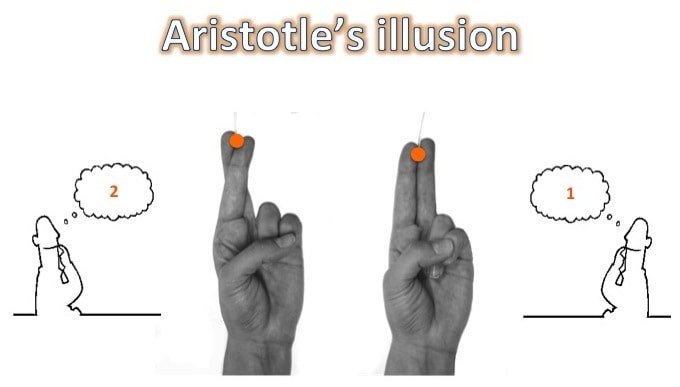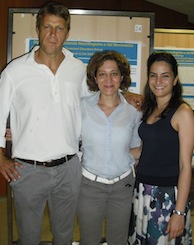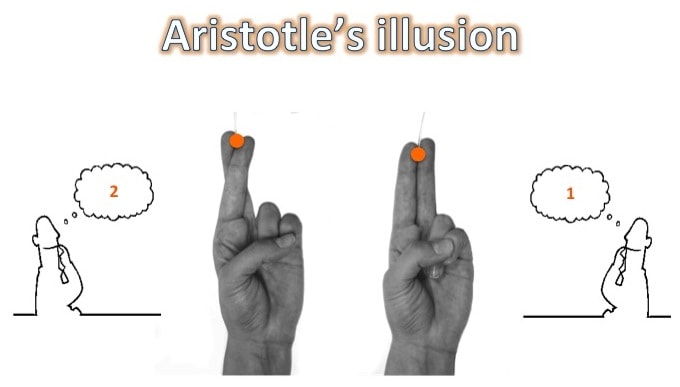Some philosophical observations can raise interesting neuroscientific questions. This is the case of the so-called “Aristotle’s illusion”. Aristotle (in Metaphysica IV, 6) first noticed that by crossing the fingers, one gets the illusion of doubling a single stimulus positioned in the contact point of the fingertips. This type of tactile illusion occurs because an unusual configuration of the body (i.e. crossed fingers) causes a distortion in the perception of a physical stimulus and it is explained by the functional correlation between adjacent and non-adjacent skin regions of the fingers (Benedetti, 1986).
 In our study (Tinazzi et al., 2013), we applied, for the first time, Aristotle’s illusion paradigm to investigate the impairment of somatosensory processing in patients with focal hand dystonia, in whom the relation between fingers can be altered by the presence of a motor symptom. Surprisingly, we found that patients with focal hand dystonia presented a significant reduction of the illusion on the unaffected digits (fourth and fifth digits) of the affected hand and this reduction correlated with the severity of motor symptoms.
In our study (Tinazzi et al., 2013), we applied, for the first time, Aristotle’s illusion paradigm to investigate the impairment of somatosensory processing in patients with focal hand dystonia, in whom the relation between fingers can be altered by the presence of a motor symptom. Surprisingly, we found that patients with focal hand dystonia presented a significant reduction of the illusion on the unaffected digits (fourth and fifth digits) of the affected hand and this reduction correlated with the severity of motor symptoms.
Based on previous evidence showing that the sensory signals coming from the fourth digit determine lower activation in the somatosensory cortex than those coming from the fifth digit (Nelson et al., 2009), we suggest that in the crossed position, the tactile information conveyed by the fifth digit prevailed over the fourth digit, thus resulting in the perception of one stimulus. The reduction of the illusory doubling perception, therefore, may represent the functional correlate of the different level of activation between the fourth and the fifth digit in the somatosensory cortex.
Authors’ brief biography

Michele Tinazzi is associate professor in Neurology at the Department of Neurological and Movement Sciences of the University of Verona, Italy. He obtained his PhD in Neuroscience at the University of Verona in 2003. Since 2011 he coordinates the PhD course in Neuroscience at the University of Verona. His scientific interests regard both basic and clinical research, using different methodological approaches such as behavioral assessments, psychophysics, neurophysiological, neuroimaging and genetic testing, and clinical observation. The main research topics are related to movements disorders, and more recently to their psychogenic forms.
Mirta Fiorio is assistant professor in Psychobiology at the Department of Neurological and Movement Sciences of the University of Verona, Italy. She obtained her PhD in Psychological and Psychiatric Sciences (supervised by Salvatore M. Aglioti) in 2005. Her studies regarded the sensory and cognitive functions in movement disorders, in particular in dystonia. Her current research interests regards the top-down modulations of motor performance in healthy subjects and patients with movement disorders.
Angela Marotta is PhD student in Neuroscience at the Department of Neurological and Movement Sciences of the University of Verona, Italy. She obtained her Master’s degree in Clinical Psychology at the University of Padua (supervised by Franca Stablum) in 2010. Her studies regarded the alterations in cognitive functions resulting from brain damage (degenerative disorders, stroke, traumatic brain injury) and the somatosensory alterations in movement disorders. Her current research interests concern the tactile perception in dystonia and in Parkinson’s disease patients.
References
Benedetti F (1986). Tactile diplopia (diplesthesia) on the human fingers. Perception, 15 (1), 83-91 PMID: 3774481
Nelson AJ, Blake DT, & Chen R (2009). Digit-specific aberrations in the primary somatosensory cortex in Writer’s cramp. Annals of neurology, 66 (2), 146-54 PMID: 19743446
Tinazzi M, Marotta A, Fasano A, Bove F, Bentivoglio AR, Squintani G, Pozzer L, Fiorio M. (2013) Aristotle’s illusion reveals inter-digit functional somatosensory alterations in focal hand dystonia. Brain 136 (3), 782-789



